Originally published in “Boom: The Journal of California”
Punk rock, hip-hop, reggae/dub and world music burst forth simultaneously and marked the receding waves of worldwide revolt that, in 1968, appeared on the verge of “changing the world.” They were an enunciation of failure and a denunciation of surrender… They carried forward a militance and internationalist spirit into the next phase of musical and political contestation, while exposing jagged rifts left by unsuccessful struggle.
-
-
- —Mat Callahan, The Trouble with Music
We didn’t know it at the time. The revolution we thought was on the horizon was not going to overthrow capitalism or usher in an era of solidarity and mutual aid. On the contrary, the word “revolution” in the mid-to-late 1970s held a much darker potential. By the time Reagan got elected in 1980, the process of reasserting the power of capital over a recalcitrant and rebellious American working class was well underway. The “revolution” we would experience in the 1980s produced a massive U-turn, a return to the savage dog-eat-dog, everybody-for-herself, go-go capitalism that first emerged in the late nineteenth century. With several decades of hindsight, we can see now that we were at the dawn of the neoliberal city in those bleak days that for some of us felt so full of potential.
In San Francisco, we danced ourselves into a frenzy to the deafening punk rock of the Avengers, the Dils, the Mutants, the Dead Kennedys, and dozens of other bands, including touring British bands like The Clash, the Sex Pistols, the Buzzcocks, Stiff Little Fingers, Gang of Four, and many more. The music—brash, anthemic, compelling, and urgent—was the soundtrack of our time, a time we thought would finally banish the daily banality of pointless work and hollow consumerism, ubiquitous corruption, and imperial hubris that was at the heart of the tottering United States. The shows were in strange lost corners of San Francisco, the Deaf Club on the second floor of a Valencia Street building near Sixteenth; the Temple Beautiful, a huge abandoned Synagogue on Geary just west of Fillmore, next door to Jim Jones’s People’s Temple; Valencia Tool & Die, in a basement under Valencia near Twenty-first; the Mabuhay Gardens (Fab Mab), a Philippine eatery tucked among the strip clubs on Broadway in North Beach; 330 Grove Street, a fabled home to radical left and black political groups. But the epic sounds of revolt, the declarations of refusal, the hilarious ridiculing of the powerful and rich, the pointed satire of the emerging technosphere, turned out to be more of a last anguished demand to seize the moment between the lost utopias of the 1960s and early 1970s and the capitalist triumphalism that dominated the rest of the century.
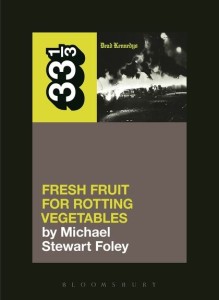 Michael Stewart Foley gives us a particular window on that musical revolt in his very enjoyable Fresh Fruit for Rotting Vegetables about the Dead Kennedys’ first album of the same name—Foley’s contribution to Bloomsbury’s 33 1/3 series of “books about albums.” Having their album as the spine of his narrative arc, Foley necessarily puts the Dead Kennedys at the center of the era. I loved the Dead Kennedys and saw them many times between 1978 and 1981, but I remember them rather differently than his account has it. They were part of a much larger and strongly politicized culture that flourished in San Francisco during that mostly forgotten interregnum between what we might call the “long sixties” and the Reagan restoration. The punk/new wave scene was a very visible and dynamic element, but radical politics were percolating in many forms and places alongside the punk music scene. Copying machines were finally becoming cheap and accessible, and many people began putting their collages, screeds, and cartoons on the poles and walls of San Francisco. Underground radio gained new life on local college stations KUSF and KALX, providing vital airtime for obscure bands from near and far. DJs like George Epileptic filled three hours every weekday morning with the biting satire and the angry sounds of dozens of new bands basically saying “Fuck you” to mainstream America. Meanwhile, the antinuclear Abalone Alliance was mobilizing thousands to block PG&E’s plans to build a nuclear power plant on the coast at Diablo Canyon; Nicaraguan revolutionaries and Iranian students crisscrossed the Bay Area urging support for the overthrow of the US-sponsored dictators in their respective countries; tenants were organizing for rent control in the wake of the violent eviction of the I-Hotel in 1977; and strikes at local oil refineries, trucking operations, insurance offices, and restaurant chains dovetailed with a national coal miners’ strike. President Jimmy Carter moved steadily rightward throughout his presidency, and being a former Navy nuclear engineer, in fact, rather than the “peanut farmer” of his mythology, he was increasingly seen, at least in our circles, as a deeply reactionary tool of the military-industrial complex. For many of us, the prospect of Carter losing to Reagan was inconceivable, the country having slid so far right under his regime that there was no way it could go further—add this to a long list of our badly off-the-mark prognostications! One local street theater group took the name “Reagan for Shah” to dramatize the absurdity of his campaign.
Michael Stewart Foley gives us a particular window on that musical revolt in his very enjoyable Fresh Fruit for Rotting Vegetables about the Dead Kennedys’ first album of the same name—Foley’s contribution to Bloomsbury’s 33 1/3 series of “books about albums.” Having their album as the spine of his narrative arc, Foley necessarily puts the Dead Kennedys at the center of the era. I loved the Dead Kennedys and saw them many times between 1978 and 1981, but I remember them rather differently than his account has it. They were part of a much larger and strongly politicized culture that flourished in San Francisco during that mostly forgotten interregnum between what we might call the “long sixties” and the Reagan restoration. The punk/new wave scene was a very visible and dynamic element, but radical politics were percolating in many forms and places alongside the punk music scene. Copying machines were finally becoming cheap and accessible, and many people began putting their collages, screeds, and cartoons on the poles and walls of San Francisco. Underground radio gained new life on local college stations KUSF and KALX, providing vital airtime for obscure bands from near and far. DJs like George Epileptic filled three hours every weekday morning with the biting satire and the angry sounds of dozens of new bands basically saying “Fuck you” to mainstream America. Meanwhile, the antinuclear Abalone Alliance was mobilizing thousands to block PG&E’s plans to build a nuclear power plant on the coast at Diablo Canyon; Nicaraguan revolutionaries and Iranian students crisscrossed the Bay Area urging support for the overthrow of the US-sponsored dictators in their respective countries; tenants were organizing for rent control in the wake of the violent eviction of the I-Hotel in 1977; and strikes at local oil refineries, trucking operations, insurance offices, and restaurant chains dovetailed with a national coal miners’ strike. President Jimmy Carter moved steadily rightward throughout his presidency, and being a former Navy nuclear engineer, in fact, rather than the “peanut farmer” of his mythology, he was increasingly seen, at least in our circles, as a deeply reactionary tool of the military-industrial complex. For many of us, the prospect of Carter losing to Reagan was inconceivable, the country having slid so far right under his regime that there was no way it could go further—add this to a long list of our badly off-the-mark prognostications! One local street theater group took the name “Reagan for Shah” to dramatize the absurdity of his campaign.Reading Foley’s Dead Kennedys book brought me back into those first years of my life in San Francisco. It’s hard to imagine now.
-
I arrived in San Francisco from Sonoma County where I had tried “country living” during a couple of years in college, after growing up in Oakland. In the last days of 1977, I was fired for trying to start a union at a Books Inc. store in Santa Rosa, so I decided to move to San Francisco where I was spending a lot of time anyway, and I found a job canvassing for an environmental group. Like a lot of young adults I’d grown up listening closely to rock ‘n’ roll, but was weary of the overproduced stadium bands and glam-rock sounds that dominated mainstream radio and album sales. New Wave was breaking, and whether one preferred edgier “punk” or peppy, exciting, and minimalist new wave, the music germinating in small clubs and on tiny labels in San Francisco wasn’t just fresh and pleasingly “unprofessional.” Bands went nowhere if they didn’t also have something angry and subversive to say, and in late 1970s San Francisco most of them did.
In January 1978, I moved to the Haight-Ashbury. Like many twenty-year-olds, I gravitated to that neighborhood because I figured that’s where it was “happening,” unaware that whatever was happening there had petered out years earlier. I discovered I was in a relatively derelict part of town, living near the corner of Haight and Cole in winter 1978. The “upper Haight,” close to Golden Gate Park, was about 50 percent boarded up, and the street was dominated by alcoholics and junkies. A few cafes, restaurants, and shops traded on the neighborhood’s reputation, and the I-Beam was a popular night spot for disco, but by all accounts the Haight was in bad shape.
I found an apartment to share via the index-card-based Roommate Referral Service, an indispensable resource in those pre-Internet days. My rent was $125 a month for half a large one-bedroom apartment, and my windows opened onto a view of the three-story, graffiti-and-poster-covered wall of the abandoned Haight/Straight Theater. At the corner on the topmost part of the facade was a blue and red Vietcong flag, it being only three years since the United States ignominiously decamped from its embassy in Saigon as Vietnam was finally reunified under communist North Vietnam. Across Haight Street I could see the Theater Club, a grungy bar from which patrons would spill out nightly into often brutal and sometimes fatal fights.
The lower Haight between Divisadero and Market in those days was considered part of the Fillmore and was overwhelmingly African American. The east-west Page Street was mostly black from Market Street all the way to Golden Gate Park. The 1960s urban “renewal” bulldozers had leveled a large swath of the Fillmore, displacing thousands—and many of them ended up in the dilapidated Victorians of the Haight. I was part of the first trickle of young whites, many of us students, who were enthusiastically moving back into cities because we liked city life. In the following years, it became a trend and then a torrent. In the wake of this demographic shift that became gentrification, the black population of San Francisco fell from its 1970 peak of about 100,000 to less than 40,000 today—and the exodus/eviction continues.
The year I landed in The City, 1978, was also the year that President Jimmy Carter announced that he would reestablish draft registration. I, like most of my peers, had anxiously watched the ping pong balls of the draft lottery bounce during the early 1970s, imagining if we were old enough that the lottery number would matter. By the time it would have been my turn in 1975, the draft had been halted, and the war had been definitively lost. Thus, I was never subject to the draft, nor the registration that started three years later, a lucky window through which all of us 1957 babies fell—around 3.2 million young men.
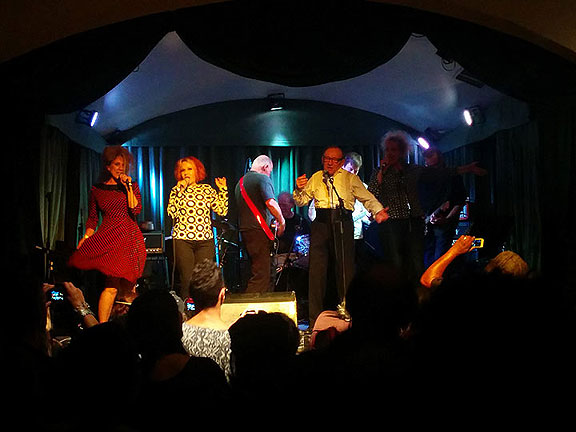
The Mutants reunited at the Punk Rock Renaissance show at the Verdi Club, Sept. 26, 2015.
Photo: Chris Carlsson
President Gerald Ford had told a bankrupt New York City to “drop dead” in 1975, refusing to rescue the scourge of middle America from the crescendo of landlord arson, racist redlining, epidemic drug abuse, soaring violent street crime, and its collapsing industrial economy. The emergence of the “Rust Belt” in the once mighty industrial heartland had pushed organized labor into xenophobic reaction as unions scrambled to defend their members’ vanishing status as “middle class Americans.” In San Francisco, a parallel process was underway, exacerbated by more than a decade of urban renewal engineered by a modernist, social engineering philosophy at the city’s Redevelopment Agency with the support of big capital and local unions. Social movements erupted to oppose the neighborhood wreckers, movements that were augmented by radicalized students from the bloody San Francisco State Strike in 1968 and 1969. Earlier campaigns to block freeways and stop nuclear power seeded strong citizens’ organizations with ecological and Jane Jacobs–like urbanist values. Campaigns to block high-rises and prevent “Manhattanization” merged with neighborhood and architectural preservation efforts. Combined with elements of the New Left and community organizations, a progressive majority elected George Moscone mayor in 1975 and a year later voted in district elections for the city’s Board of Supervisors. With district elections, gay activist Harvey Milk finally won election, as did the first elected black supervisor, Doris Ward, and also an unrepentant conservative horrified at the changing city, a former cop and former fireman, Dan White.
By the late 1970s, the powerful dockworkers union had seen its former control of San Francisco’s port disappear when shipping moved across the bay to the new container port in Oakland. Coffee, beer, bread, canned produce, and most of the city’s once-thriving industrial economy were closing down, too, leaving empty factories and warehouses from North Beach through the South of Market to the Mission and farther south. These spaces, emptied of their original uses, were repurposed by the gay leather scene, the punk scene, the lesbian community, artists, computer pioneers, musical innovators, small theaters, and cross-pollinating communities of dissenters and radicals of many stripes.
Punks rallied to support striking coal miners in March 1978 with a big benefit at the Mabuhay Gardens. There was an instinctual solidarity with working class movements at the time, even though the local economy, dominated by the rising tourist and finance economy, was barely unionized. President Carter had ignored his support from labor and done nothing to stop the wave of plant closures across the country while he embraced the “solution” of deregulation. Locally, the restaurant workers in Local 2 carried out a successful insurgency against a corrupt union boss in 1978 and elected a rank-and-file slate only to see the old guard co-opt the newly elected officials. Within a couple of years, the Hotel Employees and Restaurant Employees Union had put Local 2 into trusteeship, derailing the bottom-up democratic surge that threatened the status quo. In 1981, newly elected Reagan broke the Air Traffic Controllers Union, declaring open season for capital to attack long-entrenched unions. A new wave of defeats and rollbacks accelerated from which organized labor has never recovered, a key element in clearing the field for the neoliberal restructuring of the economy.
In fall 1978, I enrolled at San Francisco State, a campus still haunted by the dramatic and violent student and faculty strike a decade earlier. I joined up with some other student leftists, and we realized the state budget shortfall imposed by the reactionary tax revolt embodied in the passage of Proposition 13 that summer was going to shrink available resources for the university. This was during Jerry Brown’s first governorship, and his flip-flopping embrace of the tax revolt fueled a visceral rejection of his pusillanimous politics (one of the Dead Kennedys best tunes was “California Über Alles,” in which Governor Jerry Brown “always smiles and never frowns” and would employ the “suede denim secret police” to engineer a new fascism).
We organized against cutbacks in state university budgets, not realizing that we were at the dawn of a systemic shift to eliminate low-cost higher education. The new, much more expensive model would establish years-long debt peonage for students who took the loans that would allow them to attend college, trapping graduates into accepting any paid work they could get as soon as possible. Meanwhile, the tax revolt became an ideological and populist foundation for the privatization of public goods that is the heart of neoliberalism. The global counterpart imposed as the “Washington consensus” by the International Monetary Fund and the World Bank was precipitated by the so-called “debt crises” in the Third World. Privatization and public asset stripping proliferated around the world under the satisfied guidance of multinational capital with strong US military backing.
At San Francisco State in the fall of 1978, we felt far removed from the city and its politics. The Third Worldist shift of left politics meant we paid closer attention to Chile, Nicaragua, Southeast Asia, and Iran. The campus’s location at the far southwestern corner of the city keeps it physically and politically separated from the rest of town. Commuting through the gray Sunset district in my bumper sticker-covered VW bug, I was a college student like the rest; but unlike the rest, I was already committed to avoiding the careerism that dominated curricular choices for most. I read Marx, studied Spanish, and organized with other members of the tiny chapter of the Union for Radical Political Economics to create a minor in political economy, a coded label for a Marxist approach to social sciences. I don’t know if it ever was established, since I quit school after May 1979 and never looked back. By the time I quit college, I was thoroughly dismayed by my fellow students, who, in my view, were sleepwalking toward an empty life. In the wake of the November 1978 People’s Temple Jonestown massacre, many people began to use the expression “drinking the Kool-Aid” to characterize people who were willingly going to their own deaths (which we now know was largely false about the victims of Jim Jones). On my way out of the university, I began calling it “Jonestown State,” for the zombie-like way most of the student body seemed to be pursuing business degrees.
It was during that dark fall of 1978 that San Francisco was traumatized by the Jonestown tragedy (hitting San Francisco’s black and left communities hardest—many of the more than 900 dead were well known former allies), and just days later the world really did seem to spin out of control when Dan White murdered Mayor Moscone and Harvey Milk in City Hall. Dianne Feinstein, the rich matron politician who had come in a dismal third in the 1975 mayoral contest and was considered to be finished politically, was president of the Board of Supervisors, and thus ascended to the now vacant mayor’s office. Her regime quickly changed directions from Moscone’s liberalism. Feinstein wasted no time in shifting mayoral support to downtown interests, opposing renter protections, and supporting a new office building boom. Foley is good on how much we all hated Feinstein (unlike David Talbot’s weirdly hagiographic treatment of her in his best-selling Season of the Witch), and how the Dead Kennedys’ political lyrics were partly inspired by that vitriol:
By the late summer of 1979, Dead Kennedys fans churned and bounced to any number of favorite songs, including “Let’s Lynch the Landlord.” Given the context of the time and place, though, it might as well have been called “Let’s Lynch the Mayor.” On the one hand, the song, which grew directly out of experiences Jello Biafra and Klaus Flouride had with a landlord when they lived together, provides a description of living in an apartment where nothing works—not the water, the heat, the oven—where the ceiling leaks, there are roaches and some asshole is “blasting disco down below.” On the other hand, it is not a stretch to imagine the mayor lurking in the lyrics as Biafra sings “I’m doubling the rent … you’re gonna help me buy City Hall.” The chorus about lynching the landlord is, therefore, both transgressive and cathartic, particularly if the landlord might have been Dianne Feinstein. In the wake of her brutal crackdowns on punks and open shilling on behalf of real estate interests (including her own), playing a song like that provided a momentary sense of freedom from the kind of cynical, corrupt, and sclerotic political system the mayor represented.
On 21 May 1979, the trial of Dan White culminated in a shocking “voluntary manslaughter” verdict, in what had appeared to everyone as a clear-cut case of premeditated first degree murders. (According to Talbot, White confessed to his former police colleague Frank Fanzon in 1985 that he had intended also to kill Supervisor Carol Ruth Silver and Assemblyman Willie Brown—all in defense of a city that only existed in his tortured imagination.) When the news of the verdict broke, a crowd of angry protesters gathered in the Castro and soon several thousand were marching down Market to City Hall. The “White Night Riot” ensued, hours of violent confrontation between protesters and police, fifteen squad cars up in flames, City Hall windows smashed, small fires around the Civic Center, and finally, late that night, an organized police attack on the gay Castro neighborhood that included dragging people out of their homes and invading the Elephant Walk bar at Eighteenth and Castro.
I was in the middle of the riot for hours and truly thought it was the beginning of a revolution. We had the cops on the run for a long time and dominated the plaza in front of City Hall. Squad cars burned, their sirens wailing in the smoke-filled night. It was eerie and powerful. The demographics of the rioters changed during the night too, starting with thousands of angry gay men and lesbians but swelling quickly with a big influx of young black men from the adjacent Fillmore district, finally seeing their chance to even the accounts with the racist police. The solidarity on the lines was strong, and the euphoria was incredible.
The next morning, the political fantasy was punctured by a return to mundane daily life. A couple of dozen arrests, mostly young African American men, along with my then-roommate, meant that whatever support might have materialized from the gay community was not forthcoming since none of the arrestees seemed to be gay. Our subsequent efforts to rally support through a “May 21st Defense Fund” fell flat.
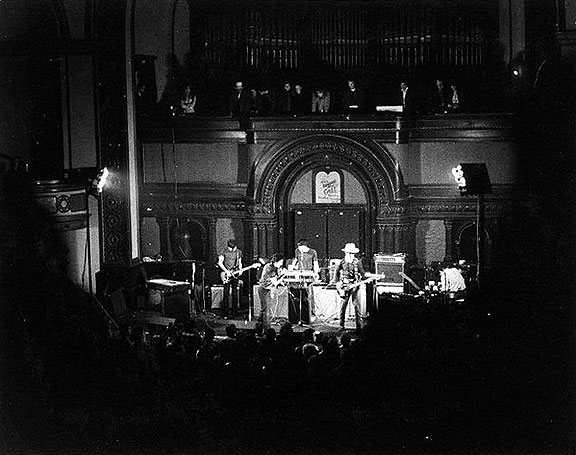
A 1979 show of the Flamin’ Groovies at the Temple Beautiful, a converted former synagogue next door to Jim Jones’ People’s Temple on Geary near Fillmore.
Photo: © Jeanne Hansen 2015
My personal life took me to the East Coast from mid-summer to the end of 1979, so I missed the Feinstein mayoral campaign and Jello Biafra’s clownish anticampaign. In general, I didn’t put any faith in electoral politics by that time, so even if I’d been in town, I don’t think I would’ve been particularly interested. In Foley’s account of the time, Biafra’s run for mayor is quite important. He cites Biafra’s article in Damage calling for “Creative Crime for the Sober Seventies” and links that to his campaign for mayor. While most people dismissed it as a joke at the time, Foley characterizes it “as political theater, as serious as a heart attack. It was also another example of the utopian performative, puncturing elaborate lies with comedic needles of truth.” Actually, the 1979 Biafra campaign follows a long line of prank electoral efforts, notably one that saw radical attorney Tony Serra run for mayor in 1972 promoting an agenda of a green, car-free central city, and decriminalization of sex and drug crimes, issues that Biafra’s campaign took up again in 1979, issues that are no longer jokes, but, instead, are now practically taken for granted in the city a generation later.
As a liberal arts college dropout, I had few marketable skills beyond my well-honed ability to work in a bureaucratic environment filling out forms, typing, processing information. I was perfect for the new office world that was expanding rapidly in the Financial District. My first gig was a job at the Downtown Community College Center, a public institution dedicated to producing clerical workers for downtown. I learned word processing on an IBM “Mag II” machine, meaning I used a punch-card-sized magnetic card to store the data I typed into what appeared to be a normal electric typewriter. I worked there for the first half of the year, engaging in radical political street theater with my pals in the Union of Concerned Commies in my spare time. Eventually, I was fired for inserting a satirical flyer in course catalogues.
In late summer 1980, I began “temping.” With my new ability to do “word processing,” my wages nearly doubled. I worked through an agency called Temps, Inc., which found me a months-long gig at the Bank of America data center. I worked on a minicomputer through a glowing green terminal, word processing the manuals that would someday soon teach bank workers around the country how to use the Bank of America system. Mind you, this was before interstate banking had been legalized, but Bank of America was sufficiently confident that they’d be able to take over banks in other parts of the country that they were already preparing the systems they’d need to profit from the process.
As I went to and from the high-security data center, and later in and out of various brokerages and Arthur Anderson accounting offices downtown, I was a cog in a much larger machine. My seemingly pointless word processing was helping to restructure the global economy at the dawn of the 1980s. The financialization of the economy that was triggered by Nixon taking the United States off the gold standard in the early 1970s was now altering daily life in San Francisco, too. Not only had container shipping undercut the Port of San Francisco and driven manufacturing out of the city, but now a burgeoning FIRE sector (Finance, Insurance, Real Estate) was taking over what San Franciscans did all day, putting us to work in the data mines of far-flung corporate networks that aimed to organize and control production on an increasingly global scale. We were the handmaidens of a new neoliberal economic order. But we didn’t see the big picture, sitting in front of Wang computers, using new-fangled software, enduring the unreliability of the new computerized office systems, all before email and the Web. For us, it was an empty charade. From this tortured experience emerged our underground magazine, Processed World, which we distributed throughout the downtown office world where we found our readers and writers. The most typical response from readers was “thank God I’m not alone!” as they discovered a kindred spirit, or as we called it, a “bad attitude.” This stance allowed the creatively stifled photographers, historians, philosophers, poets, musicians, dancers, and countless others toiling in the white collar world to find each other, to share their “tales of toil,” their wild satire, and poignant and heartfelt rebukes to an empty existence in the new cubicles of modern capitalism.
But this sensibility that we put in print did not erupt suddenly from our heads. It had been brewing all around us already for several years, prominently among the punks. This was decades before the saccharine admonition to “do what you love” came to hypnotize so many new workers in the tech and office sectors, a goal that can only be achieved through daily self-deception for the vast majority. Dozens of songs left little doubt about the repudiation and refusal at the heart of the radical subculture during that time. The Dils called for “Class War,” while the Mutants decried the “New Dark Ages;” The Avengers lambasted the country in “The American in Me.”
Writing about the Dead Kennedys, Foley aptly relates,
“Taken together, the songs on Fresh Fruit for Rotting Vegetables added up to a sustained and trenchant critique of not only the familiar New Left target, “the system,” but of mainstream culture. The lyrics show no mercy to any aspect of American life—everything is fair game. It is a no bullshit zone, a place where listeners are confronted to consider their own place in a vapid, venal, and violent society and then ask themselves what they are prepared to do. Will they just insulate themselves from the horrors the way the narrator in “Drug Me” does? Or go off the deep end, as in “Forward to Death,” and “Ill in the Head?” Will they stand by while the poor are drafted, the slums cleared, and while Zen fascists command conformity? Or will they fight back, maybe via some creative crime, the way the narrators do in “Let’s Lynch the Landlord,” “Chemical Warfare,” “Stealing People’s Mail” and “Holiday in Cambodia”? … it’s hard to escape the feeling of being put on the spot.”
Our radical aspirations went unmet. The 1980s unfolded and by most accounts seemed to get worse and worse. When Reagan was shot by John Hinckley early in his first term, the president’s plummeting popularity was restored and from that time on, few criticisms would stick to him. It was as though the national media had made a collective decision to surround the presidency with an aura of moral goodness and invincibility. Reagan’s dirty wars in Central America, arming of Islamic Taliban guerrillas in Afghanistan, support for Saddam Hussein against Iran, and general military belligerence across the planet was protested regularly in San Francisco and the Bay Area. For all its fakeness, the Reagan restoration enjoyed a carefully manufactured popularity in most of the country, much to the chagrin and confusion of radical activists in my circles.
The economy was good to speculators and financiers, but most people saw their standard of living slowly—or rapidly—eroding during the global economic reorganization of the 1980s. When the Cold War ended with the collapse of the Soviet Union and its empire after the fall of the Berlin Wall in 1989, and China fully embraced capitalist modernization, the self-congratulatory triumphalism of the United States was loudly proclaimed, precluding other views. The radicalism that once pulsed in the emptied spaces of late 1970s San Francisco was largely lost in the following decades as those spaces filled with upscale restaurants, boutiques, “lawyer lofts,” art galleries, and million-dollar condos. New radical impulses would emerge from the Zapatistas in Mexico, to the anti-globalization movement at the turn of the twenty-first century, but San Francisco’s once thriving radical scene was no longer at the epicenter. Instead, the city became the center of the misnamed “tech revolution,” which has displaced tens of thousands, while committing the survivors to a world in which work is the center of all meaning and never stops, going on twenty-four hours a day, seven days a week, whether you have a job or not. Solidarity and mutual aid are essential to many of us San Franciscans, who survived the past few decades in which a new neoliberal city emerged from the destruction of our hometown. Newcomers seem to inhabit a city in which everything is for sale. If they can’t simply pay for what they want, they react with anger and confusion. This is the city wrought by the brutal marketization of life since 1980—but it feels profoundly fragile. Cracks and fissures are everywhere, waiting for a catalyst that might unravel this dehumanized nightmare.
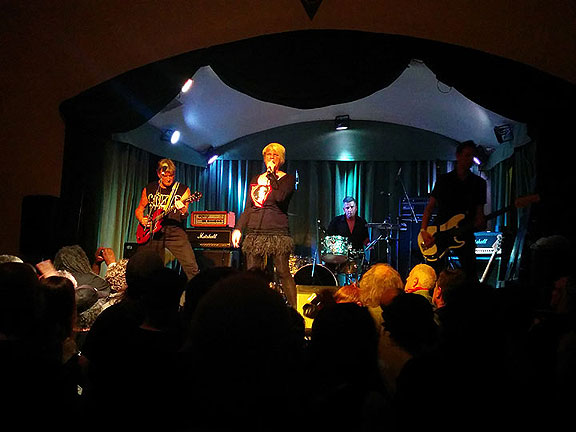
The Avengers reunited at the Verdi Club, September 26, 2015, part of the Punk Rock Renaissance Festival, playing a full set reprising all their songs and then some from their unforgettable pink album.
Photo: Chris Carlsson
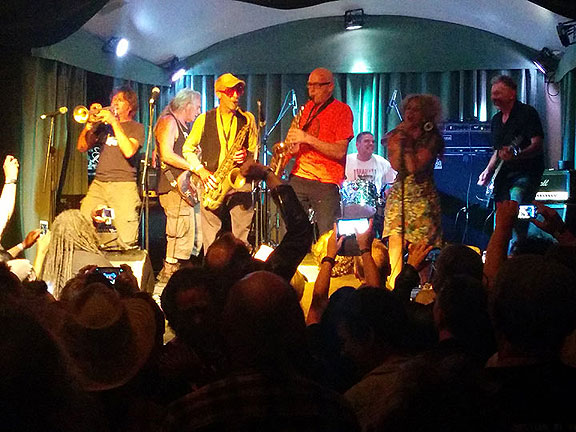
A version of the legendary band Flipper, minus long-deceased Will Shatter, played “Sex Bomb” at the Punk Rock Renaissance Show at the Verdi Club, Sept. 26, 2015.
Photo: Chris Carlsson

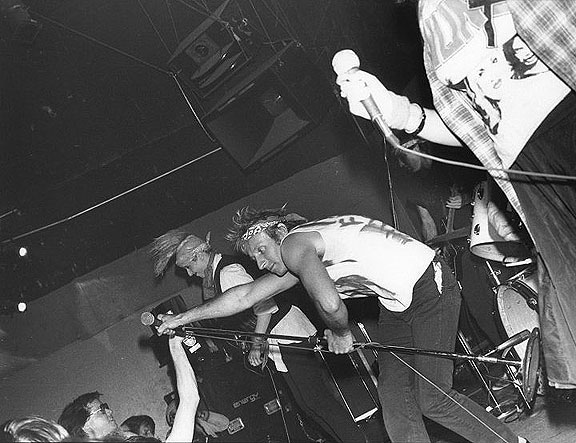












Interesting recap of the times, Chris. Good to be reminded of how it was. A lot of energy thrown at the wall and I wonder to this day how much of it stuck.